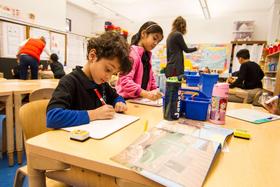Serving 100 students in grades Prekindergarten-12, Issaquah Special Services ranks in the bottom 50% of all schools in Washington for overall test scores (math proficiency is top 50%, and reading proficiency is bottom 50%).
The percentage of students achieving proficiency in math is <50% (which is higher than the Washington state average of 41%). The percentage of students achieving proficiency in reading/language arts is <50% (which is lower than the Washington state average of 61%).
Minority enrollment is 54% of the student body (majority Asian), which is higher than the Washington state average of 52% (majority Hispanic and Asian).
Quick Facts (2025-26)
- School Type: Special education school
- Grades: Prekindergarten-12
- Enrollment: 100 students
- Minority Enrollment: 54%
- Graduation Rate: ≥50% (Btm 50% in WA)
- Math Proficiency: <50% (Top 30%)
- Reading Proficiency: <50% (Top 1%)
- Source: National Center for Education Statistics (NCES), WA Dept. of Education
Top Rankings
Issaquah Special Services ranks among the top 20% of public schools in Washington for:
Category
Attribute
Diversity
Community Size
School Overview
Issaquah Special Services's student population of 100 students has declined by 32% over five school years.
School Type
Grades Offered
Grades Prekindergarten-12
(No virtual instruction)
(No virtual instruction)
Total Students
100 students
Gender %
Total Classroom Teachers
n/a
School Rankings
The diversity score of Issaquah Special Services is 0.68, which is less than the diversity score at state average of 0.69. The school's diversity has stayed relatively flat over five school years.
Math Test Scores (% Proficient)
<50%
41%
Reading/Language Arts Test Scores (% Proficient)
(18-19)<50%
61%
Student-Teacher Ratio
n/a
16:1
American Indian
n/a
1%
Asian
29%
9%
Hispanic
16%
26%
Black
2%
5%
White
46%
48%
Hawaiian
n/a
2%
Two or more races
7%
9%
All Ethnic Groups
Graduation Rate
≥50%
84%
Eligible for Free Lunch
11%
49%
Eligible for Reduced Lunch (19-20)
1%
8%
School Statewide Testing
School District Name
Source: National Center for Education Statistics (NCES), WA Dept. of Education
Profile last updated: 02/09/2025
Frequently Asked Questions
What percent of students have achieved state testing proficiency in math and reading?
<50% of students have achieved math proficiency (compared to the 41% WA state average), while <50% of students have achieved reading proficiency (compared to the 61% WA state average).
What is the graduation rate of Issaquah Special Services?
The graduation rate of Issaquah Special Services is 50%, which is lower than the Washington state average of 84%.
How many students attend Issaquah Special Services?
100 students attend Issaquah Special Services.
What is the racial composition of the student body?
46% of Issaquah Special Services students are White, 29% of students are Asian, 16% of students are Hispanic, 7% of students are Two or more races, and 2% of students are Black.
What grades does Issaquah Special Services offer ?
Issaquah Special Services offers enrollment in grades Prekindergarten-12 (No virtual instruction).
What school district is Issaquah Special Services part of?
Issaquah Special Services is part of Issaquah School District.
In what neighborhood is Issaquah Special Services located?
Issaquah Special Services is located in the North Issaquah neighborhood of Issaquah, WA.
School Reviews
Review Issaquah Special Services. Reviews should be a few sentences in length. Please include any comments on:
- Quality of academic programs, teachers, and facilities
- Availability of music, art, sports and other extracurricular activities
Recent Articles

Bullying, Name-Calling & Put-Downs: Parent Guide 2025
Practical tips for parents to address bullying, name-calling, and put-downs鈥攚ith 2025 data, policies, and expert strategies.

What Is a Magnet School? (2025 Guide)
Explore what a magnet school is, how it works, and its benefits in 2025. Clear explanation for parents, students, and educators.

Cooperative Learning in 2025: Evidence, Best Practices & Challenges
Explore cooperative learning in 2025鈥攏ew data, updated practices, expert insights for educators and families.




